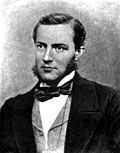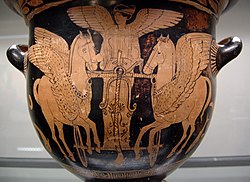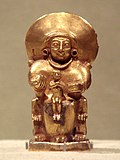Proto-Indo-European mythology
Proto-Indo-European mythology is the possible mythology of the Proto-Indo-Europeans.[1] These are the people who spoke the Proto-Indo-European language. Scholars believe many mythologies like Greek mythology have elements from it.[2]
Proto-Indo-European Mythology Media
Trundholm sun chariot, Nordic Bronze Age, c. 1600 BC
Portrait of Friedrich Max Müller, a prominent early scholar on the reconstruction of Proto-Indo-European religion and a proponent of the Meteorological School.[3]
Zoroastrian deities Mithra (left) and Ahura Mazda (right) with king Ardashir II.
Eos in her chariot flying over the sea, red-figure krater from South Italy, 430–420 BC, Staatliche Antikensammlungen, Munich.
Possible depiction of the Hittite Sun goddess holding a child in her arms from between 1400 and 1200 BC.
Related pages
References
- ↑ "Ancient Mythology: The Proto-Indo-European Pantheon | European Origins". Archived from the original on 2023-05-11. Retrieved 2023-05-11.
- ↑ West, M. L. (2007-05-24). Indo-European Poetry and Myth. OUP Oxford. ISBN 978-0-19-928075-9.
- ↑ Puhvel 1987.






